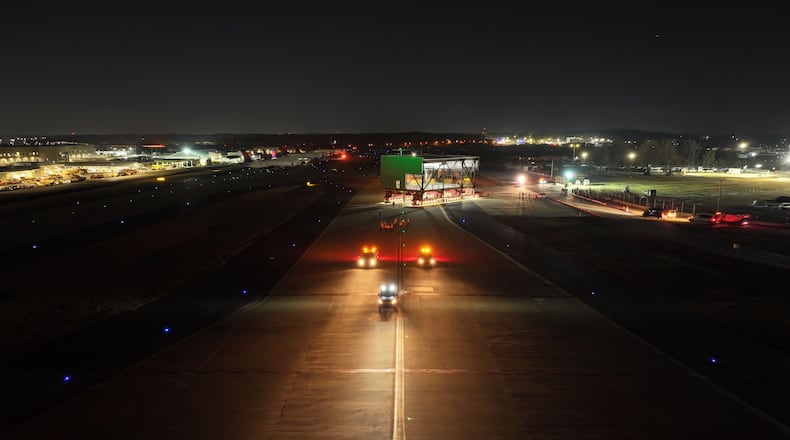The last modular piece of the northside expansion of Hartsfield-Jackson International Airport’s Concourse D is now in place: a milestone in the $1.4 billion, nearly seven-year project set to last to 2029.
The narrowest concourse at the world’s busiest airport is being strategically expanded to limit how many gates are lost at a time.
“People are still walking up and down the corridors of this concourse as we’re doing it,” said Frank Rucker, the airport’s senior deputy general manager for infrastructure.
That sets the project apart from modular construction at other airports, which normally involves adding on totally new terminals or concourses, not expanding an existing space.
The hybrid, modular process that began in 2022 involves building parts of the new concourse on the edge of the airport and rolling them into place overnight.
The last modular move for about two years happened overnight last week. Its five new gates are set to open at the end of the year.
Now, the several hundred people working on the project will turn to more traditional construction behind walled-off sections of the north half of the concourse, until the southside modular pieces are ready in 2027.
“It represents a milestone but still we’ve got to be aware we’ve still got so much further to go,” Rucker said last week.
Credit: Source: Hartsfield-Jackson
Credit: Source: Hartsfield-Jackson
The strategy was crafted to continue allowing Delta Air Lines to operate gates in the concourse as it happened, Rucker said. They “couldn’t afford” to lose them all.
The project is being funded by Delta, airport bonds and the federal government.
Delta initially wanted just four gates to be affected, Rucker said, but that would have pushed the timeline well into the 2030s. They compromised with eight gates being closed at a time.
The new Concourse D will accommodate much larger planes, and grow nearly 40 feet in width, as well as add higher ceilings, larger gate areas and bigger restrooms.
Doing the expansion in this way means a faster timeline, and less lost airport revenue from missing gates and concessions, said Pete Pemantell with Holder Construction Co., who is leading the project team.
“We would have loved to have just shut everything down, demolished it, and built it with modules to bring it out there. But that would have shut down 20 or so gates at a time, which isn’t ideal for the airport.”
Credit: Kelly Yamanouchi
Credit: Kelly Yamanouchi
This strategy is not typical for an airport project, agreed Mary Williams, a structural engineer for the project with Thornton Tomasetti.
The plan was possible because the airport was “forward-thinking” and open to modular construction, she said.
It was also willing to keep some of the existing structure in place, she said.
“Everyone always thinks bright and shiny at airports, and they want to do the new things. And this is a different way to keep it operational.”
About the Author
Keep Reading
The Latest
Featured






